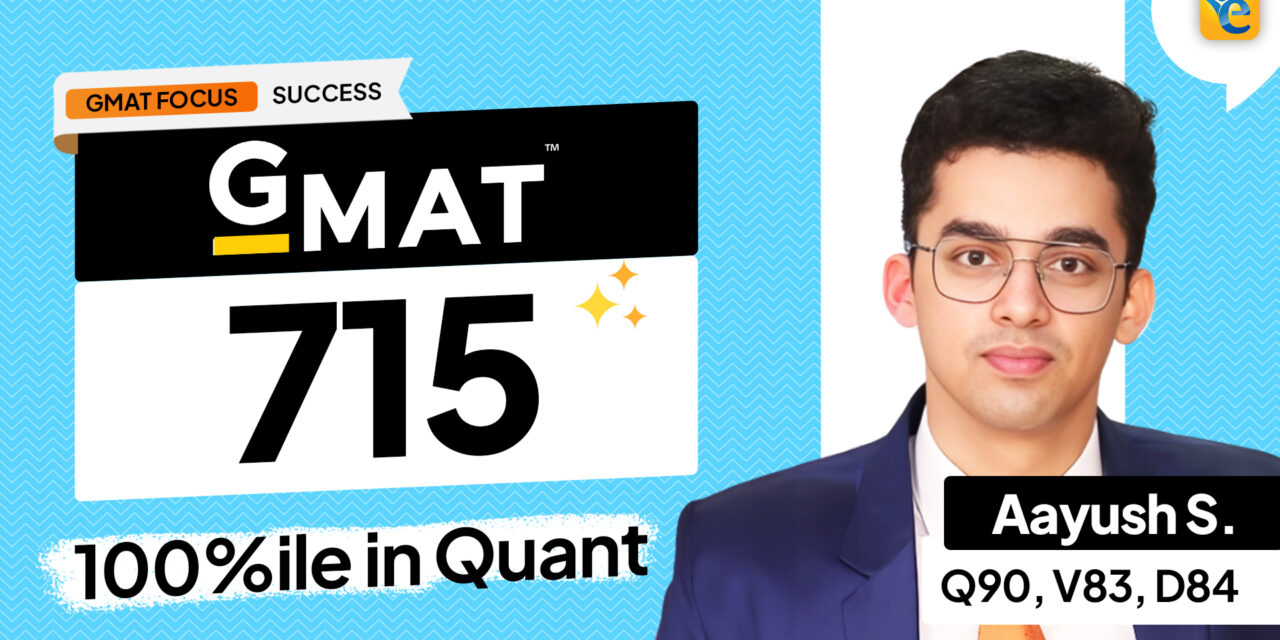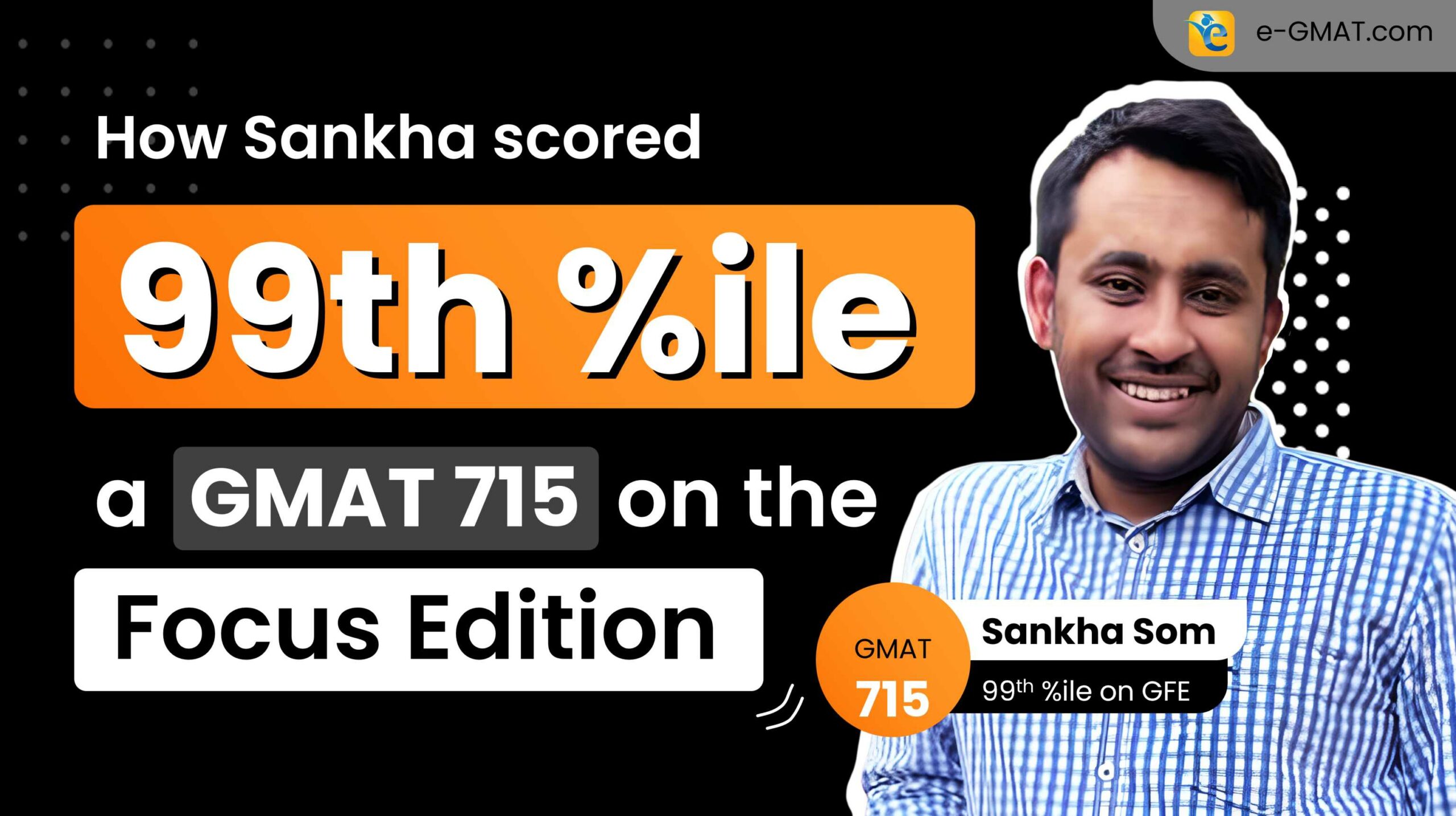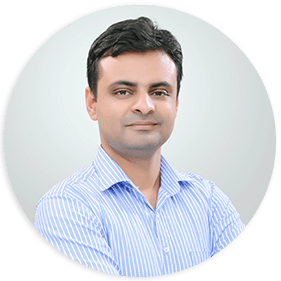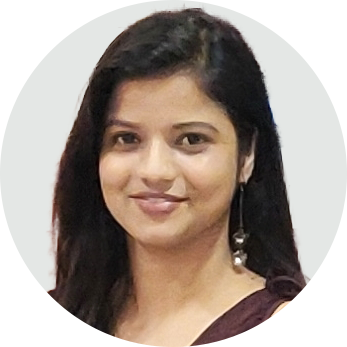For most GMAT aspirants, achieving a perfect score in any section feels like a distant dream. For Aayush, a software engineer, this dreamed turned into reality through a journey that transformed an initial disappointment into a story of strategic triumph, culminating in a 715 score with a perfect Q90.
After scoring 98.03 percentile in his first CAT attempt and improving to 99 percentile in his second, Aayush initially approached GMAT with similar confidence. “I thought GMAT shouldn’t be much difficult for me,” he recalls. Using free resources and self-study, he took his first step – a free mock test that revealed an unexpected reality.
Meet Aayush, who scored 715 on the GMAT
The Power of Strategic Analysis
“If anyone wants to make an improvement, whether they’re at a 555 score or a 755 score,” Aayush emphasizes, “they have to go through the process of drilling down the mistakes and going multiple levels at the analysis.” This philosophy became the cornerstone of his entire GMAT journey.
Aayush’s success stemmed from a systematic transformation across all sections:
- Data Insights Mastery
- Developed “owning the data set” mindset
- Created systematic time management strategy
- Achieved 97th percentile through focused practice
- Quant Excellence
- Shifted from quantity to quality in practice
- Implemented rigorous error logging
- Achieved perfect score through pattern recognition
- Verbal Enhancement
- Developed structured pre-thinking approach
- Created frameworks for Reading Comprehension
- Built systematic elimination process
While each section demanded its own approach, Aayush’s transformation began with conquering Data Insights – a journey that would establish the analytical framework for his entire GMAT success story.
Data Insights: Transforming a Weakness into Strength
Aayush’s journey to a DI84 (97th percentile) began with a stark realization in his first mock test – scoring 77 with only 50% accuracy in Multi-Source Reasoning (MSR). This section would become the testing ground for his analytical approach to GMAT preparation.The issue wasn’t just accuracy – it was time management.
“MSR was a black hole for time. Even with fair accuracy, I was left with very little time for later questions, forcing me to rush and make silly mistakes.”
Rather than simply practicing more questions, Aayush developed a systematic approach focused on mastering MSR.
A glimpse at Aayush’s MSR approach:
The “Owning the Data Set” Principle
Aayush adopted a principle that would transform his MSR approach: treating each data set as if he had written it himself. “I should know the passage so thoroughly that all questions become second nature,” he explains. This meant:
- First Pass: Thorough understanding of every detail
- Mental Mapping: Creating clear data relationships
- Question Approach: Minimal reference back to passage
- Time Management: 7-8 minutes per complete MSR set
As we can see from the below Scholaranium snapshot, Aayush’s Multi-Source Reasoning performance showed remarkable progression, with accuracy on hard questions increasing from 55% to 75% while consistently reducing completion time to 7-8 minutes per set. This systematic improvement in MSR played a crucial role in elevating his overall Data Insights score from 77 to 84 (97th percentile).

Implementation and Results
The effectiveness of Aayush’s systematic approach extended beyond just MSR mastery. His Scholaranium statistics in the picture below show comprehensive improvement across all Data Insights question types:
- Graphical Interpretation: Hard accuracy improved from 43% to 73%, with average time per question dropping from 2:54 to 2:42
- Table Analysis: Maintained high accuracy while reducing time significantly
- Data Sufficiency: Increased hard accuracy from 73% to 93%
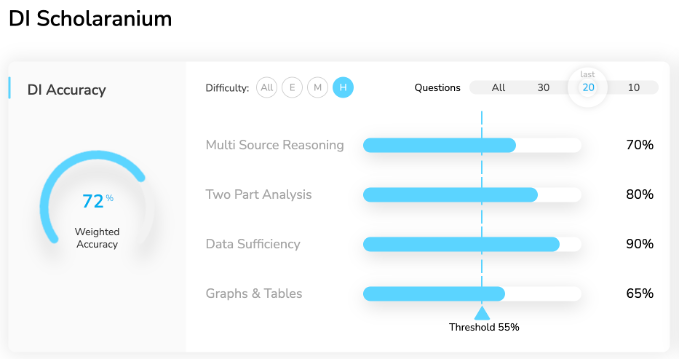
This holistic improvement in every DI component, combined with his mastery of MSR, ultimately led to his impressive DI84 (97th percentile) achievement.
“Towards the end, I focused only on hard questions and questions I was regularly getting wrong,”
This systematic approach to Data Insights would prove invaluable as Aayush turned his attention to his next challenge: transforming his strong Quant performance into a perfect score. The principles of thorough analysis and strategic practice would become even more crucial in achieving the elusive Q90.
Quantitative: Engineering the Perfect Score
While many GMAT aspirants dream of a Q87, for Aayush it served as a wake-up call. His journey from Q87 to a perfect Q90 demonstrates how even strong performers can achieve excellence through strategic refinement.
How did Aayush improve from Q87 to Q90?
Beyond Traditional Practice
Despite Quant being his strongest section, Aayush’s initial Q87 revealed a crucial insight: excellence requires more than just solving problems. “Being an engineering student, I have always had this idea that questions are solved on paper,” he explains. This strength, ironically, needed refinement.
INITIAL ASSESSMENT
- Starting Score: Q87
- Primary Challenge: Silly mistakes
- Traditional Approach: High volume practice
- Key Realization: Need for strategic analysis
The Mentor’s Impact
A pivotal moment came through mentor guidance: “You specifically mentioned that we do not have to write every test left right and center. The most important part is to analyze the mistakes.” This insight led to a fundamental shift in approach.
Instead of pursuing more practice, Aayush implemented a rigorous error log system:
- Detailed documentation of each mistake
- Pattern identification in errors
- Strategic adjustments based on findings
- Focused practice on identified weaknesses
The results of these efforts are clearly visible in Aayush’s Scholaranium stats below, which show his exceptional ability on hard questions, maintaining a consistent 80+ accuracy, thus indicating his readiness for a Q90 score.

Aayush’s approach to Quant mastery focused on three key areas:
- Quality Over Quantity
- Thorough analysis of each mistake
- Pattern recognition in error types
- Strategic practice targeting weaknesses
- Time Management
- Reduced time per question through understanding
- Consistent pacing across question types
- Strategic time allocation based on difficulty
- Pattern Recognition
- Identified common trap patterns
- Developed quick recognition strategies
- Built confidence through understanding
The effectiveness of this approach was evident in the final result of a perfect Q90
“The exam felt like a breather. Once you are accustomed to the higher difficulty level questions in Scholarinium, the official exam seems manageable.”
While achieving Q90 marked a significant milestone, Aayush’s systematic approach to improvement would prove equally valuable in tackling his final challenge: elevating his verbal performance. The principles of strategic analysis and focused practice would become crucial in this next phase of his GMAT journey.
Verbal: From Logic to Language Mastery
For Aayush, like many engineers, Verbal presented a unique challenge. His improvement from V79 to V83 represents a crucial shift from purely analytical thinking to a more nuanced understanding of language.
“Being an engineering student, I have always had this idea that questions are solved on paper,” Aayush explains. While this approach served him well in Quant and DI, Verbal—particularly Reading Comprehension—demanded a different mindset.
INITIAL VERBAL CHALLENGES
- Reading Comprehension: Difficulty in moving beyond paper-based solving
- Answer Selection: Stuck between two close options
- Time Management: Excessive time on option analysis
- Accuracy: ~50% in RC sections
Aayush developed a comprehensive verbal approach that leveraged his analytical strengths by centering everything around pre-thinking. He built a structured process where he would thoroughly analyze the passage or argument structure, predict answers before looking at options, and then systematically eliminate choices.
How did Aayush use Prethinking to Improve in Verbal?
This strategy particularly resonated with his engineering mindset, allowing him to apply logical frameworks to verbal questions. The effectiveness of this approach showed in his metrics – his Critical Reasoning hard accuracy improved from 70% to 87%, while his Reading Comprehension accuracy on hard questions reached 80%. The image below gives us a glimpse into his meteoric improvement in CR Assumption’s block questions, which primarily utilise the pre-thinking approach

His performance remained consistent through the end of his preparation, maintaining 80% accuracy on hard CR questions and improving RC accuracy from 75% to 80% in his final practice sets. This systematic approach ultimately helped him improve his overall Verbal score from V79 to V83.
While Verbal may have been his biggest challenge, Aayush’s systematic approach to improvement—proven successful in DI and Quant—ultimately yielded results here as well. His journey demonstrates that with the right strategy, even the most challenging sections can be mastered.
From Analysis to Excellence: Key Learnings
Aayush’s journey to a 715 (99th percentile) showcases how strategic analysis and focused improvement can lead to exceptional results. His experience offers valuable insights for future GMAT aspirants.
Aayush’s Advice to Future Test Takers:
FINAL ACHIEVEMENTS
- Initial Scores: Q87 V79 DI77
- Final Scores: Q90 V83 DI84
- Timeline: Strategic two-week focus for major improvements
- Result: 99th percentile overall

The rigorous preparation through Scholaranium and focused practice paid off on test day. “The exam felt like a breather,” Aayush recalls. “The difficulty level of practice questions is so high that once you are accustomed to it, the official exam seems manageable.”
Aayush’s journey demonstrates that GMAT success isn’t just about knowledge or practice volume—it’s about strategic improvement and systematic analysis. His transformation from strong performer to exceptional achiever proves that with the right approach, even seemingly minor improvements can lead to breakthrough results.
Are you planning to pursue MBA at top business schools? Let us help you conquer the first step of the process i.e., taking the GMAT. Take a free mock test to understand your baseline score and start your GMAT prep with our free trial. We are the most reviewed online GMAT Prep company with 2000+ five star reviews on GMATClub.


